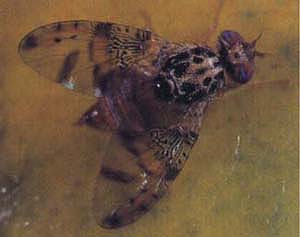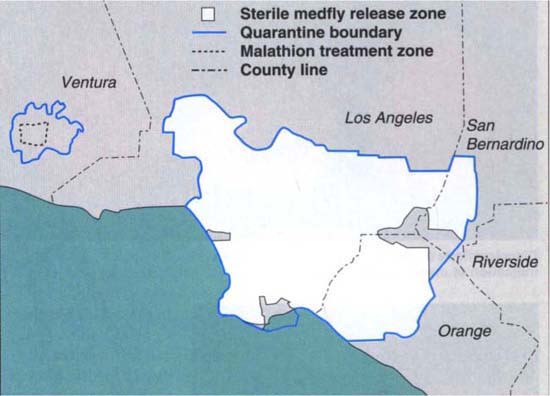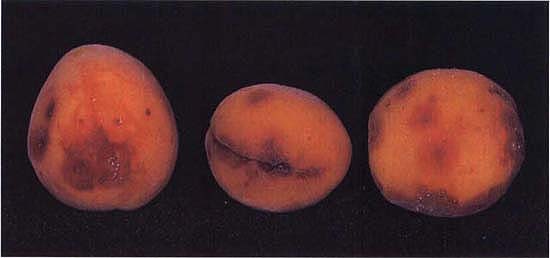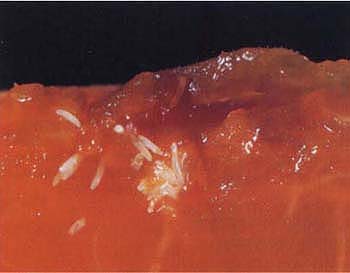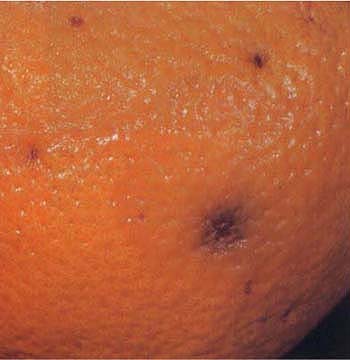All Issues
Medfly problem simmers
Publication Information
California Agriculture 49(4):4-6.
Published July 01, 1995
PDF | Citation | Permissions
Full text
Out of sight but definitely not out of mind, the fruit-destroying Mediterranean fruit fly has triggered new concerns among California growers and scientists. Here's why:
-
Last fall 66 adult medflies and hundreds of larvae were found in Ventura County at a Camarillo seminary that grows citrus and row crops.
-
Since then, crops considered to be medfly hosts in the surrounding 86-square mile area have been under quarantine. The California Department of Food and Agriculture (CDFA) finished treating the area with aerial malathion sprays on May 23, 1995.
-
The L.A. Basin is also under quarantine, imposed after 400 wild adult medflies were captured there in 1993.
-
Starting in March 1994, CDFA began releasing an average of 518 million sterile medflies per week in a 1,464-square mile area of the L.A. Basin at an annual cost of $34 million.
In this issue, UC Berkeley agricultural economist Jerome Siebert and UC Davis graduate student Todd Cooper report potential economic impacts if the medfly were found to be permanently established in California (see page 7 ). They estimate that increased costs of controlling the medfly would range from $493 million to $875 million. They project further that if Asian countries imposed a trade embargo on California produce, it could cost the state $1.2 billion a year in gross state product and more than 14,000 jobs.
The medfly can attack more than 250 plant species and threatens high-cash crops such as citrus and stone fruit.
The UC study has added a new sense of urgency to efforts to stop the medfly. The Citrus Research Board has allocated $400,000 for medfly research in 1995, an amount that ballooned from $20,000 in 1992. “Now it's everybody's hot button,” says Ted Batkin, Citrus Research Board manager. “Everyone recognizes the scope [of the problem] is much greater.”
The imposition of an embargo would particularly hurt the citrus industry, resulting in 20% revenue losses — $564 million based on 1992 export values. Japan alone buys approximately 30% of the state's citrus crop.
According to CDFA's Primary State Entomologist Robert Dowell, the medfly is not permanently established here and is currently being eradicated. While some scientists say the medfly has been eradicated and reintroduced several times, others say a low-level medfly population has been continuously present in parts of urban California for several years.
Medflies have been captured in California 13 different years since 1975 and every year since 1986. Twelve eradication programs have been mounted against this pest at a cost of $260 million. (The CDFA has spent $130 million on these efforts; the US Department of Agriculture pays for the other half.)
In Camarillo, Dowell notes, CDFA has finished its aerial applications of malathion. Eradication will be declared if one life cycle passes (after treatment ends) with no wild flies trapped. Dowell expects the post-treatment monitoring to be done by the end of July, but notes that cool weather has slowed the process this year. “We have to wait for it to get warm enough for the next life cycle to be completed,” he says.
Before being moved out of quarantine areas, crops must receive one of three treatments: malathion spray, cold storage, or postharvest methyl bromide fumigation. The quarantines may be lifted as early as July if the CDFA declares eradication complete.
After consulting two groups of university and government scientists, CDFA and USDA officials decided to treat the entire Los Angeles Basin as one area. “People are continuously bringing infested produce into the area and moving into other areas of the basin,” explains Dowell. “We want to eliminate [the medfly] by treating the entire area at once.” Weekly sterile fly releases are intended to eradicate any medfly infestations that are present and to prevent new generations from starting. They will continue until March 1996.
Quarantines are imposed and overseen by the Cooperative Medfly Project, which is run by representatives of USDA, CDFA and county agricultural offices. Because some foreign markets are not accepting fruit from quarantine areas, the Cooperative Medfly Project set up a fruit tracking system to let buyers know where fruit has been grown and packed. For instance, Ventura County fruit is labeled with a diamond stamp and the number 56.
“If medflies reappear,” says James Carey, UC Davis entomologist, “then the Japanese in particular will really take stock and probably reassess the situation,”
Carey believes the pest is already established and he is trying to use ecology and invasion biology to predict what will occur if eradication efforts fail.
“I'm considering invasion in five phases. Phase 1 was colonization and establishment,” he explains. The medfly was first detected around Culver City in 1975. Phase 2 was expansion of range throughout the LA Basin from 1975 through the 1980s. I think we're beginning phase 3, where they escape from the Basin, the first harbinger being the Ventura County out-break. They caught a few in San Diego and Oceanside in 1992 and 1993.
“Phase 4 is colonization of the interior of the state. In Phase 5, establishment is complete; essentially they colonize all areas where they can survive — all coastal areas, much of the Central and certainly the Imperial Valley and maybe the High Desert.”
Carey estimates it will take several decades before establishment is complete and that it won't be uniform. If the medfly were to spread statewide, he says, the resulting damage would vary according to climate zone. The medfly would thrive better in Southern California than in the cooler Northern Central Valley. “We can factor in the ecology of medfly to estimate the economic impact,” he says.
UC research on the medfly
Currently there are five UC scientists doing medfly-related research. At UC Davis, James Carey is collaborating with colleagues in Greece on a project to reveal the medfly's overwintering behavior. UC Riverside entomologist Jocelyn Millar has begun work to synthesize alpha copaene, a natural attractant, for use as a more effective trap bait to improve medfly monitoring. Alpha copaene is a natural hydrocarbon compound originally screened from wild parsnip, but found in other plants as well. “It doesn't seem to be related to pheromones,” he said, “but it's highly attractive to male medflies. It may have potential for some type of annihilation if turns out to be strong enough.”
UC Riverside biologist Karl Fryxell is working on genetic engineering of the medfly to achieve autocidal biological control, in which the species causes its own demise. He is studying a genetically dominant gene that will make medflies vulnerable to cool temperatures. Already Fryxell and Thomas Miller, an entomologist at UC Riverside, have successfully demonstrated the cold-sensitive dominant lethal effect of this gene in the vinegar fly, Drosophila. If the gene can be successfully introduced into the medfly population, Fryxell says, their eggs won't develop properly at temperatures under 70°F and the population will collapse. In a related project, Miller is preparing a genomic library from the medfly. All work with live medflies is being done by Fryxell's collaborator, University of Hawaii entomologist Stephen Saul, in Hawaii, where the insect is permanently established.
UCLA chemist Charles Strouse is developing a dispenser that releases oriental fruit fly attractant at a constant rate. This technology could be applied to medfly as well. — Ed.
Numerous interceptions of medfly-in-fested fruit arriving from Hawaii, Central and South America and other regions where the pest is per-manently established have led CDFA officials to believe that repeated introductions of medfly are responsible for repeated medfly captures in the state.
The medfly lays its eggs under the skin of apricot, above, and other host fruit. Two or three days later larvae emerge from the eggs.
However, genetic analysis of mitochondrial DNA indicates that California medflies did not originate in Hawaii (B.S. McPheron, W.S. Sheppard, G.J. Steck). They may have come from Central or South America, or the Mediterranean. Because data collection and analysis are still under-way, scientists can not yet say whether medflies are from a single or multiple introductions. Scientists are analyzing medfly population structure, then matching gene groups found in California medflies with those in medflies from other locations. Identifying the source of the invading medflies would influence pest management and trade policy.
Robert Metcalf, interim director of the Center for Exotic Pest Research (CEPR) at UC Riverside, believes more research is needed.
“The continuing capture of wild, fertile medflies over the last 10 years, despite the release of billions of sterile male flies and the widespread application of malathion bait sprays, clearly indicates the magnitude of the task of trying to eradicate this pest from an area as large, populous, and geographically and climatically varied as Southern California,” says Metcalf.
The problem is not just biological. A variety of factors ranging from entomological to sociological concerns must be addressed, according to Metcalf.
“First we must arrive at a mutually acceptable definition of eradication among scientists, regulators, agriculturists, and the public,” Metcalf says. “It will not be possible to arrive at this consensus without research to answer the many questions highlighted in our report, The Mediterranean Fruit Fly in California: Defining Critical Research.”
In March CEPR published the proceedings of a conference held at UC Riverside to define critical medfly research. Among the priority needs identified were developing new technologies for monitoring the nature and extent of the medfly infestation, developing less controversial control procedures and improving the effectiveness of the sterile male release program.
Originating in South Africa, the medfly has been found in at least 26 countries over the past 150 years. Today medfly research is underway in about 50 countries, says Batkin of the Citrus Research Board. “We in industry have the responsibility to insure that we don't try to reinvent the wheel in California,” he says. “We have to look at the research being done elsewhere and work in concert. That's one of great benefits of the Center for Exotic Pest Research.”
—Editor



